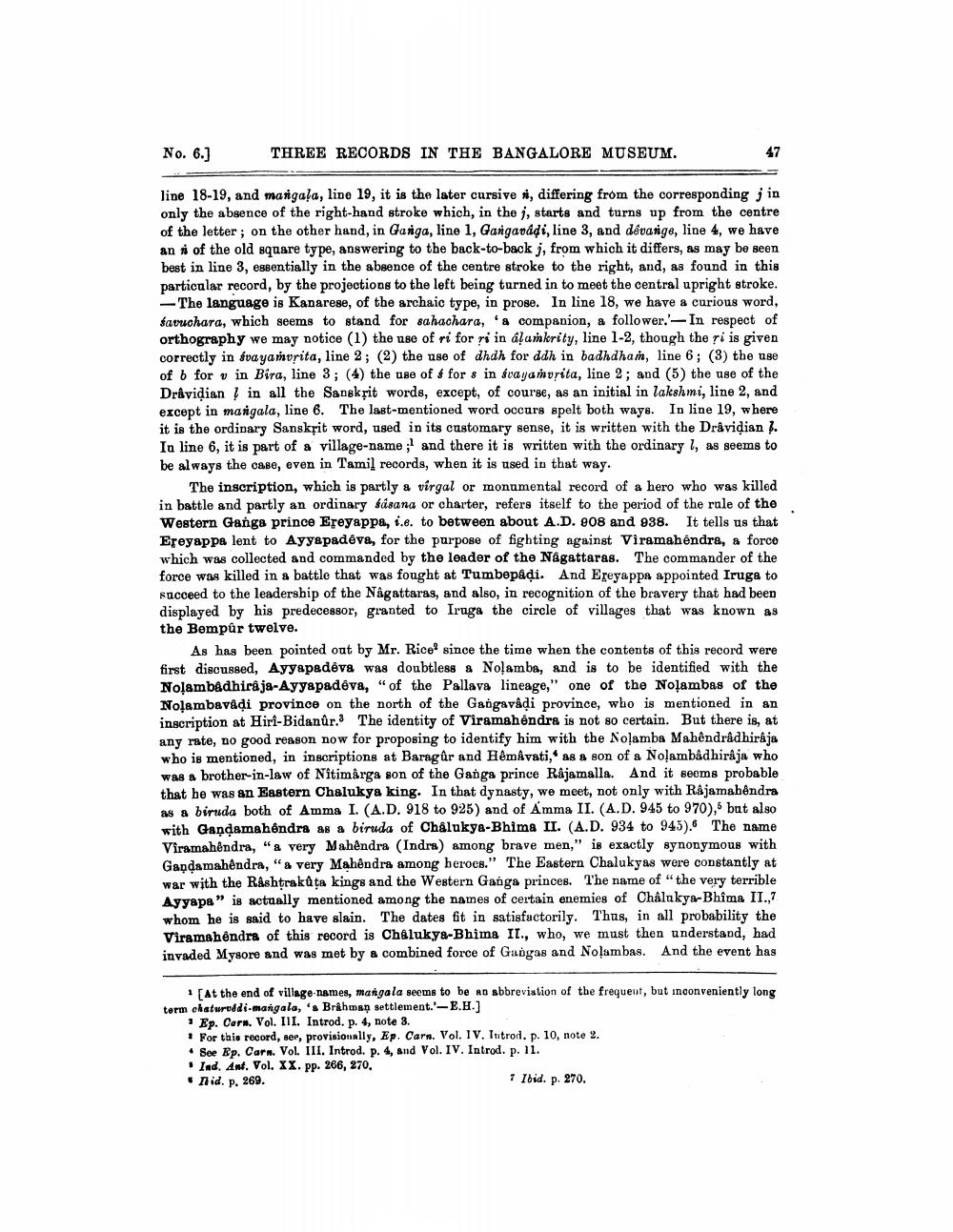________________
No. 6.)
THREE RECORDS IN THE BANGALORE MUSEUM.
line 18-19, and mangala, line 19, it is the later cursive ni, differing from the corresponding j in only the absence of the right-hand stroke which, in the j, starts and turns up from the centre of the letter; on the other hand, in Ganga, line 1, Gangarádi, line 3, and dêvange, line 4, we have an of the old square type, answering to the back-to-back j, from which it differs, as may be seen best in line 3, essentially in the absence of the centre stroke to the right, and, as found in this particular record, by the projections to the left being turned in to meet the central upright stroke. -The language is Kanarese, of the archaic type, in prose. In line 18, we have a curious word, savuchara, which seems to stand for sahachara, '& companion, a follower.'- In respect of orthography we may notice (1) the use of ri for ri in alamkrity, line 1-2, though the ri is given correctly in sva yamurita, line 2; (2) the use of dhdh for ddh in badhdham, line 6; (3) the use of 6 for v in Bira, line 3; (4) the use of $ for sin svayamorita, line 2; and (5) the use of the Dravidian in all the Sangkțit words, except, of course, as an initial in lakshmi, line 2, and except in mangala, line 6. The last-mentioned word occurs spelt both ways. In line 19, where it is the ordinary Sanskțit word, used in its customary sense, it is written with the Dravidian . In line 6, it is part of a village-name, and there it is written with the ordinary 1, as seems to be always the case, even in Tamil records, when it is used in that way.
The inscription, which is partly & virgal or monumental record of a hero who was killed in battle and partly an ordinary sasana or charter, refers itself to the period of the role of the Western Gange prince Ereyappa, i.e. to between about A.D. 008 and 938. It tells us that Ereyappa lent to Ayyapadêva, for the purpose of fighting against Viramahendra, a forco which was collected and commanded by the leader of the Någattaras. The commander of the force was killed in a battle that was fought at Tumbepaại. And Ereyappa appointed Iruga to succeed to the leadership of the Nâgattaras, and also, in recognition of the bravery that had been displayed by his predecessor, granted to Iraga the circle of villages that was known as the Bempûr twelve.
As has been pointed out by Mr. Rice since the time when the contents of this record were first discussed, Ayyapadeva was doubtless & No!amba, and is to be identified with the Nolambadhiraja-Ayyapadêva, "of the Pallava lineage," one of the Nolambas of the Nolambavadi province on the north of the Gangavådi province, who is mentioned in an inscription at Hiri-Bidanûr. The identity of Viramahendra is not so certain. But there is, at any rate, no good reason now for proposing to identify him with the Noļamba Mahendradhiraja who is mentioned, in inscriptions at Baragür and Hémávati, as a son of a Nolambadhiraja who was a brother-in-law of Nitimârga son of the Ganga prince Rajamalla. And it seems probable that he was an Eastern Chalukya king. In that dynasty, we meet, not only with Rajamahendra as a biruda both of Amma I. (A.D. 918 to 925) and of Amma II. (A.D. 945 to 970), but also with Gandamahendra as a biruda of Chålukya-Bhima II. (A.D. 934 to 945). The name Viramahendra, "a very Mahendra (Indra) among brave men," is exactly synonymous with Gandamahendra," very Mahendra among heroes." The Eastern Chalukyas were constantly at war with the Rashtrakūta kings and the Western Ganga princes. The name of "the very terrible Ayyapa" is actually mentioned among the names of certain enemies of Châlnkya-Bhima II.,7 whom he is said to have slain. The dates fit in satisfactorily. Thus, in all probability the Viramahendra of this record is Chalukya-Bhima II., who, we must then understand, had invaded Mysore and was met by a combined force of Gangas and Nolambas. And the event has
[At the end of village names, mangala seems to be an abbreviation of the frequent, but inconveniently long term chaturuddi-mangala, 'Brahman settlement.'-E.H.]
* Ep. Cars. Vol. III. Introd. p. 4, note 3. # For this record, aer, provisionally, Ep. Carn. Vol. IV. Introd. p. 10, note 2. • See Ep. Carn. Vol. III. Introd. p. 4, and Vol. IV. Introd. p. 11. • Ind. Ant. Vol. XX. pp. 266, 270, • Nid. p. 269.
7 Ibid. p. 270.




